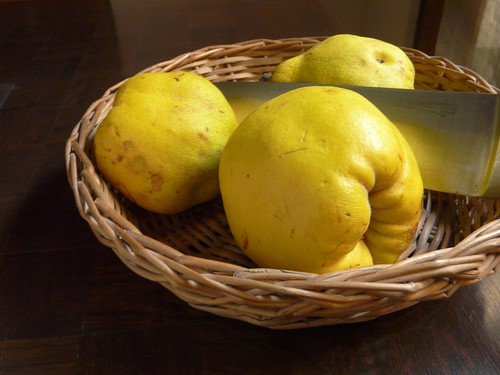Bumtchoonth (quince)
If you take a good look, you will find that the majority of the posts on this blog are around memories. Mostly memories about food. Yet, from the moment Manisha announced her IFR: Memories I seem to have been at a loss for words! Her deadline, extended, is looming and I can feel the pressure as she churns out post after daily post on IFR.
Many of my vivid memories are around food, which must be true for a lot of you. Despite nostalgia rendering most things pink, resurrecting food of our memories usually turns out well. Unless you are attempting to recreate your mother’s cooking. That one is hard to get spot on. Few can rival a mother’s prowess. Hopefully, our children will look at our cooking the same way, and we will have our spot in the limelight.
This summer, for example, before setting off for college faraway, the son finally awarded me a 10-on-10 for my rogan josh. He also added that not only had I cooked a swell rogan joshI now had my own secret ingredient for it! Which was true – I had tweaked my mother’s recipe a tad – I added a teeny weeny bit of ground mace. What was I to do – after trying in vain to match her rogan josh for ten years, I rebelled and made it better :). Well, not really. By that time I had likely put in my time – the minimum requisite to get certification – behind cooking rogan josh to have finally got the art down. Yes, recipes evolve…in an effort to better your mom’s cooking when you can’t make it just like her’s. I bet my son’s food memories are starting to stack up.
To say that Kashmiris obsess about food is to put it mildly. I am true to my community type. Growing up, I spent many a summer visiting our extended family in Srinagar. It is truly wonderful that we used to get to eat so many great meals, all home-cooked, at the homes of so many of my aunts and uncles. Except for my Nani’s house, everywhere else I was happy to stay for an extended period. There was no plan ever. You just decided to visit a relative and went. No one, including ourselves, knew how long we were planning to stay.
The morning breakfast was always tchota naan-like roti available baked fresh every morning at the Kandurwan (naansaka – baker) at the street corner. As the lady of the house put some handle on, a young cousin would run out to buy fresh tchot that was served, still warm, sometimes lathered with Amul butter, with the hot spicy handle. This is one of the recurring food memories I have about those wondrous summers. The tchot available at the Kandarwans in NOIDA, are no good compared to the original.
A memory that flashes by every now and then, is sitting down for lunch with my grandfather on a day he was fasting. He shared with us khichdi made from coarsely pounded dried singara (water chestnut). Water chestnut flour is used to make pakoras or shankarpare during fasts, but never since have I seen anyone even mention khichri. I wonder if singara grits are even available today.
Another elusive and rare fruit of this land is the bumtchoonth or quince. I had only the faintest memories of eating it but recurrent they nevertheless were, these memories. When I read bloggers rave about the quince, the craving for this somewhat exotic fruit grew stronger. A friend of mine is working on the conservation of Tibetan paintings in the monasteries of With and gets to visit the place often. Some time last year I asked him to be on the lookout for bumtchoonthand would remind him every time he was headed that way.
Then two weeks ago my mother called me over for dinner and served Bumtchoon Wangun (quince with eggplant)! A cousin had visited Kashmir and brought over some quince, cooking apples, and cranberry beans and shared the bounty with her. I can’t remember when I last ate this exquisitely paired dish. Every perfect morsel, with a bit of eggplant and a portion of quince, was mixed into the rice with a little bit of the gravy and devoured in silence.
The following day I heard from my friend – he had procured some really strange looking fruit, seemingly, a cross between an apple and a pear, which the Kashmiri shopkeeper in Leh had assured him was the bumtchoonth. He was anxious to be delivered of the precious cargo; God knows I had bothered him enough. It wasn’t really his fault that he was finding it hard to find the elusive fruit. Though much appreciated for its flavour and fragrance, quince is hard to prepare than your average fruit or vegetable. Coring it is not the easiest of jobs. Only the occasional apple grower retains a tree or two in his orchard. The markets then are not exactly overflowing with the bounty as I had imagined. Somehow Maninder had managed to procure five beautiful pieces of perfectly ripe quince!
I got no time that week to cook with them. On the weekend my parents were visiting and my father made short work of one of the quinces. He likes the mouth-puckering sweet-sour taste of quince. I understand that not all quince are edible uncooked, but the Kashmir variety, it seems, is. I was planning all kinds of things with the remaining four…
The first one was peeled, sliced, cored and poached in syrup. It is sitting in a jar in the refrigerator to be served on ice cream. The second one I made into marmalade combined with a lime from my mother’s tree. Incidentally, marmalade originally meant jam of quince! You have to make a jam or a jelly with quince to really understand how pectin-rich this fruit is! Even though my hot jam looked fluid it has jelled as if there is gelatin in there! And the colour – a most delicate salmon pink!
The cores of all have been dried and preserved. In Srinagar, quince is sold cored, and the core sold separately. The cores, pips and all, were boiled in water and the resulting liquid was prized as a conditioner for hair. Given the amount of pectin there, it must have been the equivalent of our modern-day gel! I am keeping the cores for later jam making though.
Quince Jam
1 quince, peeled, cored, and rough chopped (about 2 cups)
1 lime, sliced thin
1 3/4 C water
2 C sugar
 In a nonreactive pan simmer the quince and lime in water till the fruit is soft. Bring the cooked fruit to a rolling boil and add sugar, half a cup at a time, so that the contents continue to boil. Alternatively, warm the sugar and add to the pan. Continue to cook till setting point. To check for setting point, put a spoonful of the jam on a cold plate and chill. If a skin forms that wrinkles when pushed then setting point has been reached. Pour the hot jam into sterilized bottles and screw on the lids. When cool, wipe any spills with a damp cloth, and store. [For more on jam making read this and this.]
In a nonreactive pan simmer the quince and lime in water till the fruit is soft. Bring the cooked fruit to a rolling boil and add sugar, half a cup at a time, so that the contents continue to boil. Alternatively, warm the sugar and add to the pan. Continue to cook till setting point. To check for setting point, put a spoonful of the jam on a cold plate and chill. If a skin forms that wrinkles when pushed then setting point has been reached. Pour the hot jam into sterilized bottles and screw on the lids. When cool, wipe any spills with a damp cloth, and store. [For more on jam making read this and this.]
That above is the bonus recipe. The one that I am going to share now, Bumtchoon Wangun (quince with eggplant) is the special one. Buntchoonth wagun is a much loved dish of the Kashmiris. It was always there on the shradhha lunch menu. When quince are not to be found, they are often substituted with sour apples to prepare Tchoon Wangun. In summer, dried apples are used to prepare Tchoon Wangun. This was my first time cooking Bumtchoon Wangun. Lucky for me, at my mum’s dinner the other night I did get to refresh my memory of it while getting tips on how to prepare it.
(Quince with Eggplant)
1 quince, peeled, cored, and sliced
2 slender eggplant (light pink-purple ones preferred)
1 1/2 T fennel powder
2 t coriander powder
1 t ginger powder
1/2 t turmeric powder
1 t cayenne pepper powder
2 cloves
1 tejpatta
1 green cardamom
2 green chillies, slit (optional)
1/2 t Kashmiri or Punjabi garam masala
2 T yoghurt
a pinch hing
2-3 T mustard oil
salt to taste
Prepare quince. Halve eggplant along length, and cut into section about 2 inches long. I had 12 such sections.
 Make a thin paste of all the powdered spices with a little water and keep ready. Heat oil in a karahi and saute the quince pieces till they are golden. Remove with a slotted spoon. In the remaining oil saute the eggplant sections till golden. If you have used up all the oil then add a teaspoon more. Add hing to the hot oil, followed by cloves, tejpatta, and the cardamom. Turn heat down and add the spice paste. Cook till the water evaporates and the spices start to roast. Stir briskly so that they do not burn. Add yoghurt and stir a minute or two. Add the sauteed quince and eggplant. Add water to cover the vegetables. Add the slit green chillies and salt. Simmer, covered, till quince is tender, about 30 minutes. Add more water if needed. The dish should have a little gravy but not be watery. Take off heat. Sprinkle with garam masala and serve over steamed rice.
Make a thin paste of all the powdered spices with a little water and keep ready. Heat oil in a karahi and saute the quince pieces till they are golden. Remove with a slotted spoon. In the remaining oil saute the eggplant sections till golden. If you have used up all the oil then add a teaspoon more. Add hing to the hot oil, followed by cloves, tejpatta, and the cardamom. Turn heat down and add the spice paste. Cook till the water evaporates and the spices start to roast. Stir briskly so that they do not burn. Add yoghurt and stir a minute or two. Add the sauteed quince and eggplant. Add water to cover the vegetables. Add the slit green chillies and salt. Simmer, covered, till quince is tender, about 30 minutes. Add more water if needed. The dish should have a little gravy but not be watery. Take off heat. Sprinkle with garam masala and serve over steamed rice.
It measured up to the memory alright.
[PS: I just had some of that marmalade on toast – it is the best marmalade ever! Now all I have to do is be nice to Maninder and maybe he’ll get me some more quince!]






